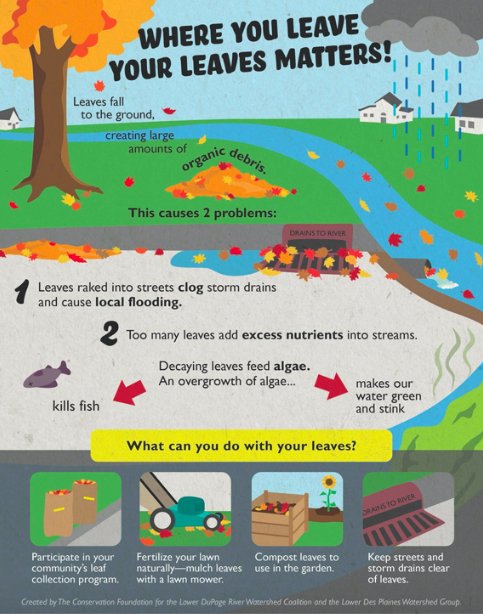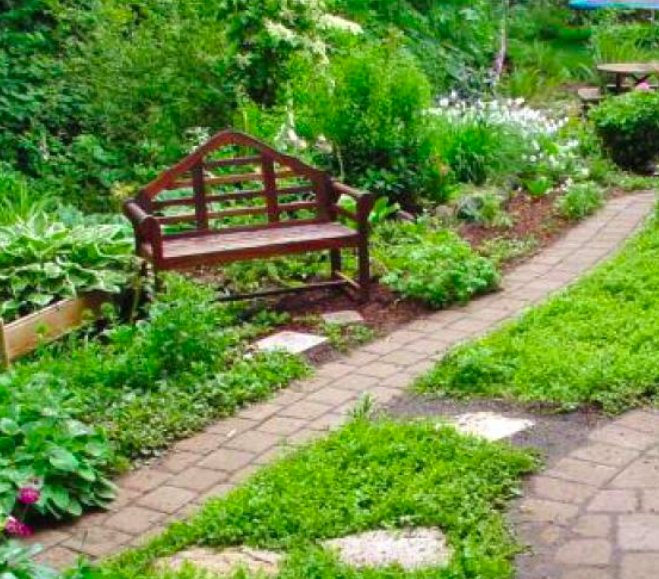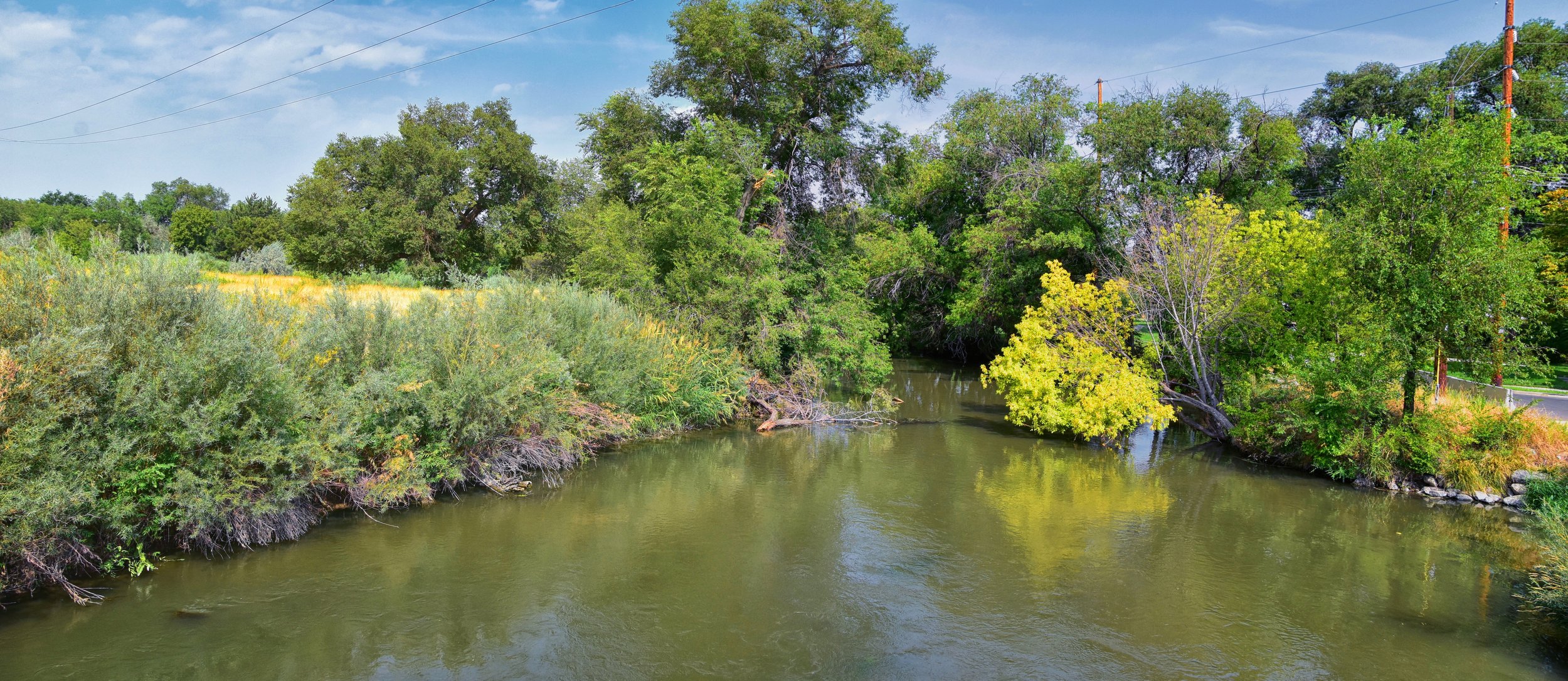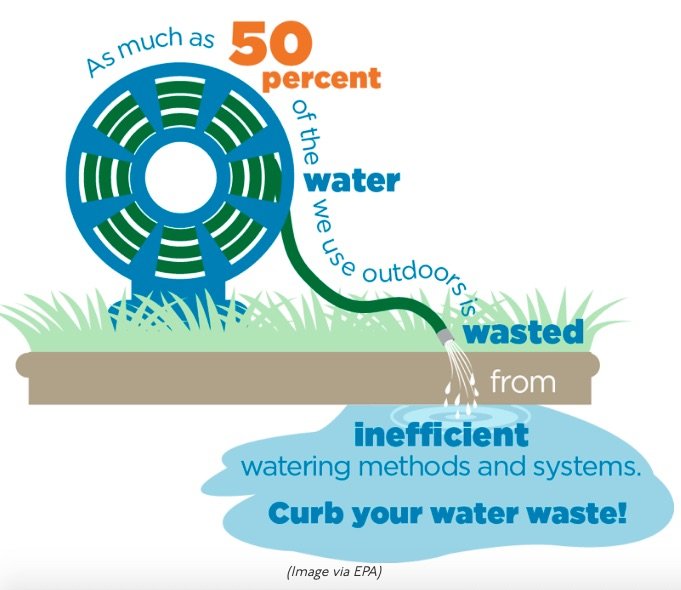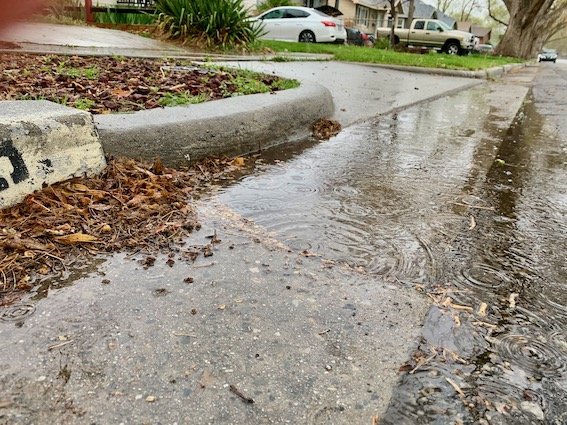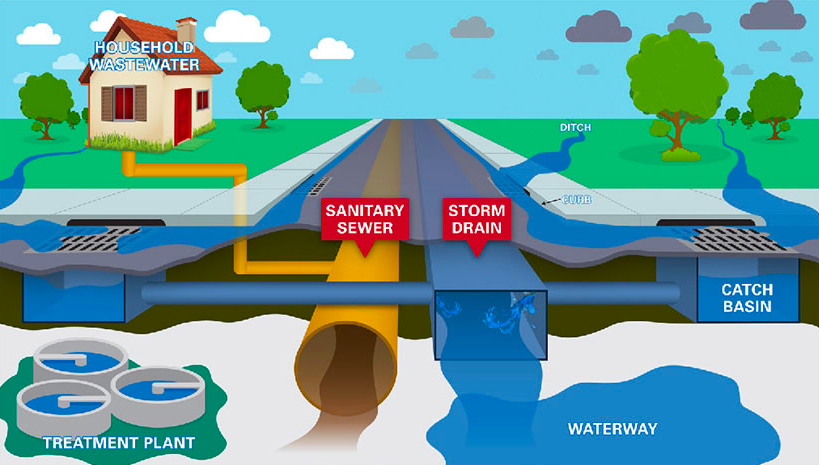Take action to improve stormwater quality!
Yard Care: Fallen Leaves, Fertilizer, Trash, and Other Organic Waste Matter Pollution
It's crucial to keep fallen leaves out of gutters and storm drains because, dry or especially when they get wet, they can cause significant blockages, leading to localized flooding during rainstorms. When leaves accumulate in these drainage systems, they can prevent water from flowing freely, increasing the risk of water damage to homes, streets, and public infrastructure.
Additionally, when leaves decompose in water, they release nutrients that contribute to the growth of algae in nearby streams, rivers, and lakes. This process, known as eutrophication, can harm aquatic ecosystems by depleting oxygen levels, making the environment less hospitable for fish and other wildlife. By keeping leaves out of gutters and storm drains, we protect our water quality, reduce flood risks, and help maintain healthier ecosystems.
Yard Care Resources- Fallen leaves
Article- Make Leaf Mold - Create Soil-Enriching Mulch with Shredded Leaves
Web Article: Everything You Need to Know About Fall Yard Care
Newsletter Article: Compost, Mulch, or Bag and Trash Autumn Leaves as They Fall
Detailed Article: USGS Study- The Connection Between Leaf Removal and Water Quality
Article + Infographic: 15 Must-Do’s of Fall Yard Cleanup
Listicle: 10 Things We Can All Do to Prevent Stormwater Pollution
Read a blogpost from EnviroSight: Fall Foliage Fouls Stormwater Runoff
Social Media Posts: Autumn Leaves
Water conservation, beautiful spring flowers, and hearty summer crops are all popular gardening goals. Unfortunately, many gardening practices used to achieve those goals contribute to stormwater pollution. We can still have beautiful lawns and gardens, while promoting the health of local water resources at the same time.
In Salt Lake County, anything that washes into gutters and storm drains leads directly to local waters. No filters. No treatment. Our approach to yard care matters in working to keep our stormwater clean.
Garden care:
Plant a rain garden of native plants, shrubs and trees that reduce the amount of fertilizer needed and provide a way for water to soak into the ground.
Install a rain barrel to collect rainwater; the rainwater can later be used to wash your car or water your plants and lawn.
Adopt techniques that utilize natural processes to manage stormwater runoff and reduce the impact of impervious surfaces on water quality.
Use pervious pavers for walkways and low traffic areas to allow water to soak into the ground.
Install a green roof on your home or business.
Incorporate best management practices, such as grassed swales, filter strips, or buffer strips on your property to control and temporarily store stormwater runoff.
Use yard waste, which includes grass clippings and leaves, in mulch or compost for your garden. If this is not an option, prepare all clippings and leaves for community composting, or in barrels or secured papers bags for disposal, which keeps them from washing into streams.
Capture Rain:
Rainwater harvesting is cost-effective and can conserve large amounts of water. It is estimated that between 15,020 - 22,940 gallons of rainwater fall on a Salt Lake County house during the spring, summer and fall. A GIS model developed at Utah Valley University found that from April through October, Salt Lake City could collect 400 - 525 million gallons of water on residential buildings alone. Incorporating rainwater harvesting practices on commercial buildings would increase this potential water savings.
Find out how much water you can collect with rain barrels from your home’s roof HERE.
Isn’t rainwater harvesting illegal in Utah? As of 2010, all Utahns are allowed to legally collect up to 2,500 gallons of rainwater on their property in covered above ground containers or in underground cisterns. If a residence is collecting rain water in more than two containers under 100 gallons or in one container above 100 gallons, they must register with the State Engineer. The process is free and can be completed in just a few minutes online.
Sweep Up!
If any lawn chemicals or yard debris get on the sidewalk or driveway, sweep them back onto the lawn to prevent them from washing into stormdrains. Even grass clippings and excess leaves don’t belong in our streams and rivers.
Sweep, don’t hose, the driveway.
Think Native and Natural
A few small changes in your lawn care practices can mean a healthier garden and less pollutants for our waters :
Consider using organic fertilizers such as bone meal, blood meal, compost, or organic blends. No matter what product you use, though, be sure to follow the manufacturer’s directions for application rate and timing.
Spread a thick layer of mulch in gardens (except for heat-loving veggies like tomatoes), around shrubs and under trees to reduce water evaporation from the soil. It also keeps the ground cooler, keeps plants happier, and inhibits weeds.
Consider letting your lawn go dormant, if there’s a drought. It will come back in the fall.
Consider planting more native plants; these are plants that have adapted to the local geography, hydrology and climate of the area. As a result, they tend to need less care, require little or no irrigation or fertilizer, are resistant to local pests and disease, and provide habitat for native wildlife species. Utah State University Cooperative Extension has published a Sustainable Plant List which is available at http://www.uri.edu/ce/factsheets/sheets/sustplant.html. You also could visit the Rhode Island Wild Plant Society website (http://www.riwps.org/) for more information about natives.
Lawn care:
To save water, reduce the amount of lawn in your yard— or even consider having no lawn at all.
If you must fertilize, apply fertilizers only when necessary and at the minimal amount.
Don't apply fertilizer before windy or rainy days.
Apply fertilizer as close as possible to the period of maximum uptake and growth for grass and other plants, which is usually spring and fall in cool climate, and early and late summer in warm climates.
Avoid applying fertilizer close to waterways.
Do not overwater lawns and garden; use a soaker hose, a porous hose that releases water directly to the ground, which can reduce overwatering that carries away fertilizers that would otherwise enrich lawns and gardens.
Fill fertilizer spreaders on a hard surface so that any spills can be easily cleaned up.
Properly store unused fertilizers and properly dispose of empty containers.
Maintain your lawn mowers, snow blowers, chain saws, leaf vacuums and similar outdoor power equipment to reduce nitrogen oxide emissions.
Make a Rain Garden:
Yard Care Outreach Resources- Fallen leaves
****Web Article: Everything You Need to Know About Fall Yard Care
Newsletter Article: Compost, Mulch, or Bag and Trash Autumn Leaves as They Fall
Detailed Article: USGS Study- The Connection Between Leaf Removal and Water Quality
Article + Infographic: 15 Must-Do’s of Fall Yard Cleanup
Listicle: 10 Things We Can All Do to Prevent Stormwater Pollution
Read a blogpost from EnviroSight: Fall Foliage Fouls Stormwater Runoff
Social Media Posts: Autumn Leaves



